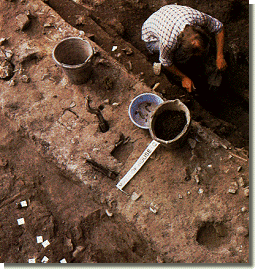
|
What are the basic steps in recording an archaeological site?
Assign a unique identification, such as a label to distinguish it
(i.e.) DcRu4, FaGt - 1.
Record the location of the site on a map accurately so that it can be relocated from a dot on a map. GPS is often used for this purpose, Geographic (Global) Positioning System.
Record surface artifacts, envirofacts and features by satellite.
Record local environment; is it near a stream, on a rocky hill, near grasslands?
Take photos of the sites and their settings.
Make a map of the site and its distributions; any disturbances should be recorded as well.
Report any information to interested parties.
( i.e.) government, aboriginals.

|
Careful labeling of objects is an essential step in producing accurate records for future use
|
Good organization is essential to the value of the records produced from an excavation. The following is the step by step method adopted by the Museum of London for the specified procedures of an excavator to follow once a context (deposit) has been identified during the dig:
Clean area
Identify limits of context (deposit in which things exist or occur)
Check with supervisor as to the need of photographs
Identify the number of grid squares in which feature lies
Take sheet(s) of permatrace (tracing paper) from file in site office
Draw a plan of the feature at a scale of 1:20 unless advised otherwise
Take relevant type of context sheet from file in site office
Take context numbers from site context registrar
Record context numbers on plan(s)
Take levels; mark spot heights on plan, record backsites and foresites on rivers of context sheet
Reduce levels to OD and transfer to plan
Describe context
Obtain finds bag and label, and enter site code and context number on label
Check with supervisor as to the suitable method of excavation, need for sampling, and method of finds collection
Excavate context, amending and adjusting description as necessary
Take finds to appropriate place
Determine relationships of newly-recorded context to previously excavated stratigraphy by overlaying plans
Cross reference relationships on context sheet and fill in matrix--material in which the objects are enclosed or embedded.
Enter date and initials on context sheet
Place plan and context sheet in relevant 'to be checked' files
All plans, context sheets, and relationships should be checked before leaving site.
Why is it necessary for archaeologists to follow such a strict protocol?
The reason for such meticulous record keeping is very important, most features are excavated and therefore destroyed. Post excavating analysis and layer by layer reconstruction of the site depends entirely on field notes. The precise location of each artifact and its surroundings must be both accurately and thoroughly recorded.
|



